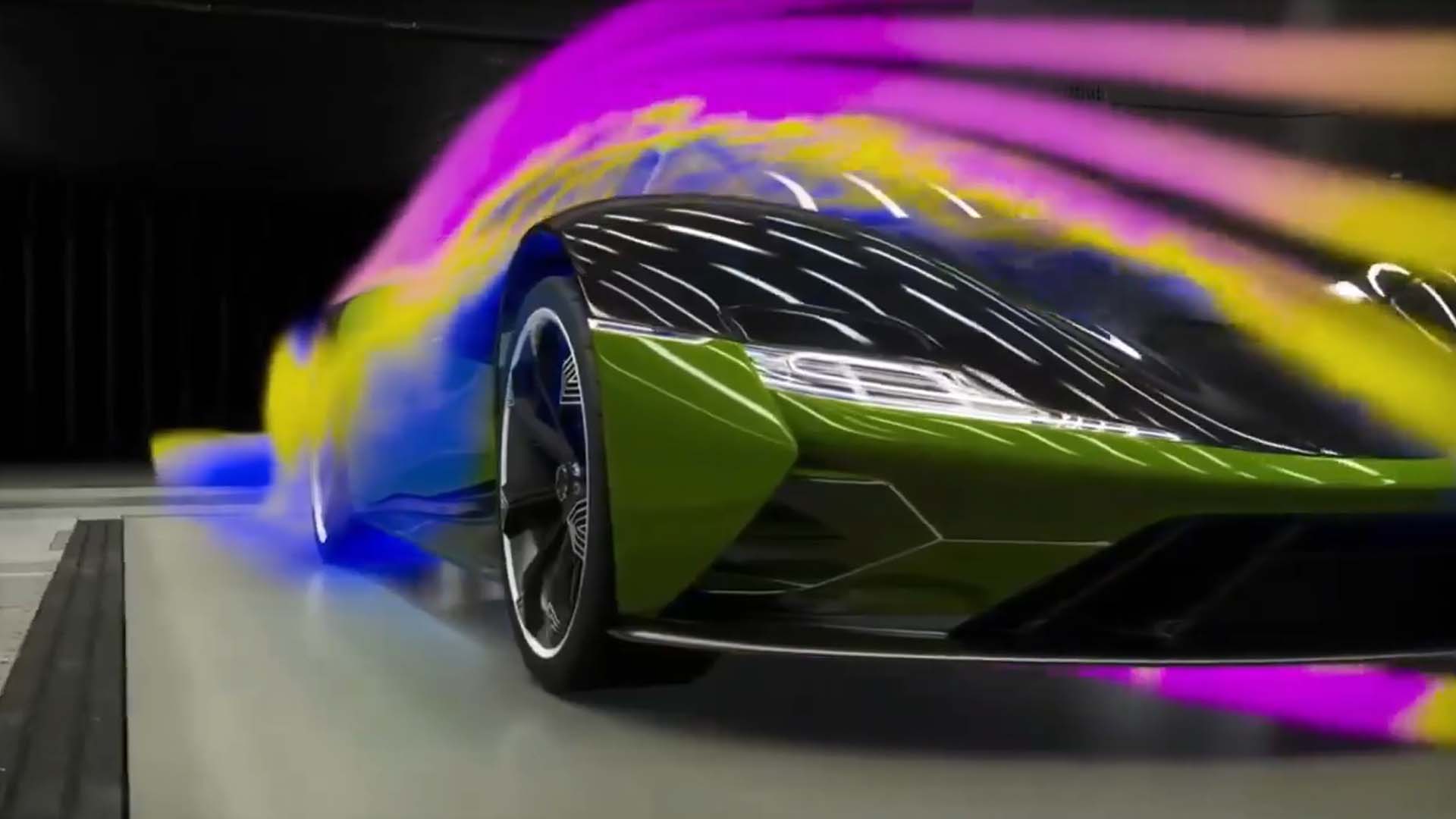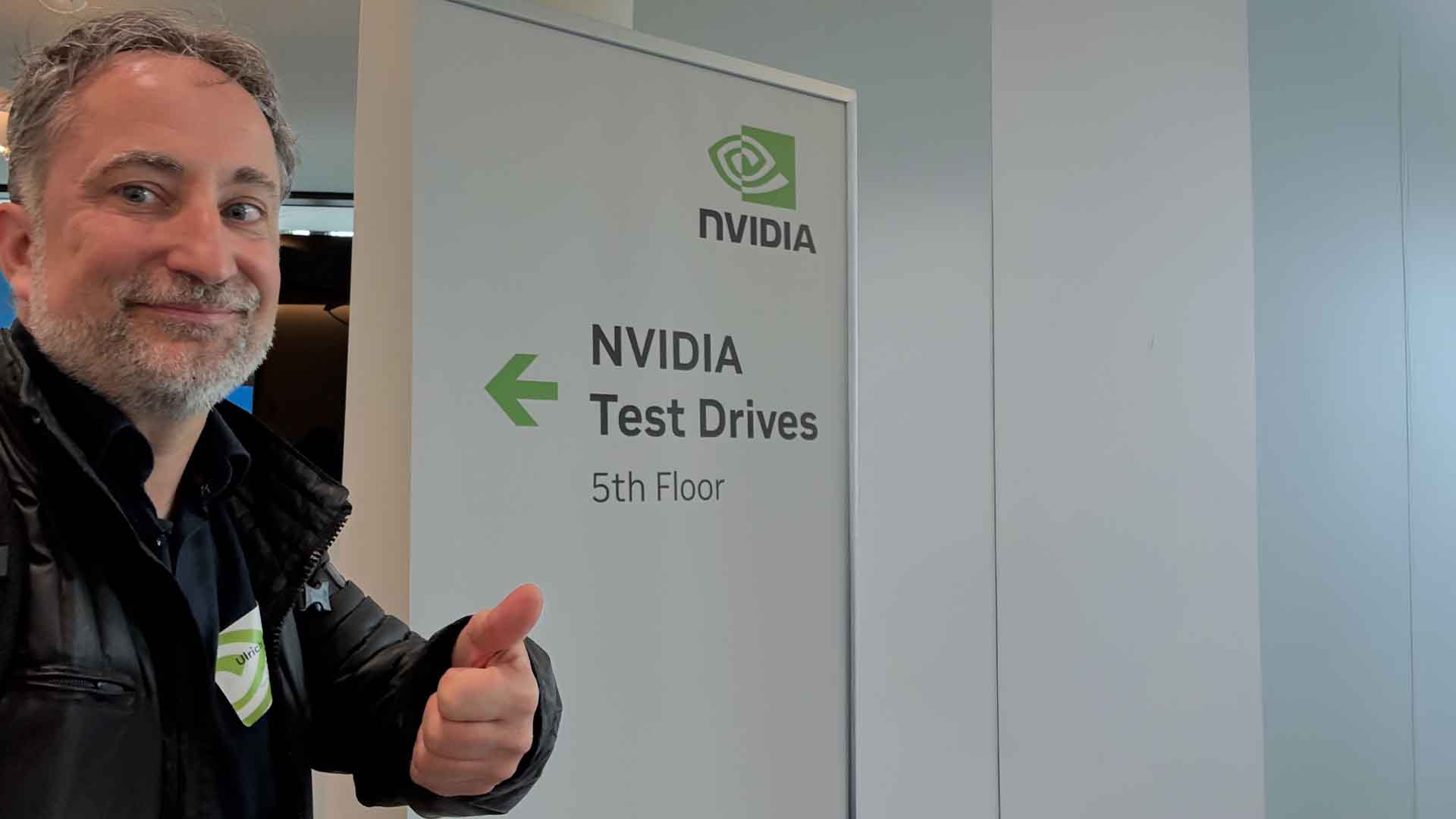VISORIC CEO Ulrich Buckenlei at NVIDIA Munich
In the photo (from left to right): Philippe van den Berge (VP Auto EMEA, NVIDIA), Ulrich Buckenlei (Digital Transformation Expert, VISORIC GmbH), Ali Kani (VP, General Manager – NVIDIA Automotive Platform), Irina Shekhovtsova (Sr. Influencer Campaigns EMEA, PhD, NVIDIA), Dr. Teo Pham (Founder TEO.AI, AI Top Voice)
NVIDIA Omniverse for Simulation and Digital Twins
At the center of the presentations at NVIDIA in Munich was the Omniverse as a key platform for the automotive industry. It was particularly impressive how the use of Artificial Intelligence can significantly accelerate flow simulations in buses. Air and energy flows can be virtually modeled and analyzed, shortening development cycles, enabling more precise safety assessments, and allowing design decisions to be made faster.
- AI-powered flow simulation for optimized aerodynamics and energy efficiency
- Digital twins for virtual representation of real vehicles and processes
- Faster evaluation of safety and driving comfort through simulation
- Significant reduction in development time and physical testing costs
This establishes NVIDIA Omniverse as the standard for the development of future vehicle generations. What once required elaborate wind tunnel tests or expensive prototypes can now be simulated in real time using AI and digital twins. With the use of machine learning algorithms, millions of data points from flow, energy, and material behavior can be linked, allowing engineers to make precise predictions about performance, safety, and efficiency long before a physical vehicle is built.

Flow simulation in the NVIDIA Omniverse: By using AI, real-world simulations are accelerated, enabling efficient analysis of air and energy flows in the bus.
Visualization created by Ulrich Buckenlei with the NVIDIA Omniverse Web Simulator | VISORIC GmbH, 2025
For manufacturers, this not only means huge time savings but also a new level of quality in product development. Design variants can be tested in parallel, extreme weather conditions can be virtually simulated, and innovative concepts such as electric drives or new battery cooling systems can be evaluated without risk. At the same time, errors are detected early, reducing costs and accelerating the rollout of market-ready vehicles. Especially in electromobility, this opens up new opportunities to optimize ranges and realistically assess energy consumption.
Through this fusion of simulation, AI, and real product development, automotive manufacturers gain an unprecedented level of speed, safety, and planning reliability. In a global market where innovation cycles are becoming increasingly shorter, this represents a decisive competitive advantage. NVIDIA Omniverse thus lays the foundation for a new era of vehicle development – faster, more sustainable, and much closer to the needs of industry and society.
Confidence in Safe Driving AI
Another key point was the question of safety in automated driving. NVIDIA pursues a multi-layered approach that goes beyond pure object recognition. Instead of simply identifying that an object is a pedestrian, the AI also assigns a “confidence score” – the probability that this assessment is correct. Based on this, the system decides how cautiously it must act.
- Perception Confidence: Each sensor (camera, radar, LiDAR) provides data with uncertainty. The AI calculates probabilities and reacts more cautiously when confidence is low.
- Decision Confidence: The system plans various maneuvers (braking, lane change, acceleration) and evaluates their risk. It always chooses the option with the highest safety margin.
- System Confidence: Redundancy in hardware, software, and sensors ensures that control is maintained even in the event of failures – essential for robotaxis and Level 3 systems.
This safety concept was illustrated using the NVIDIA DRIVE Orin and Thor platforms. Both systems deliver the enormous computing power required to process sensor data from cameras, radar, and LiDAR in real time. What matters is not just object recognition, but also the assessment of its own certainty: Every detected pedestrian, vehicle, or obstacle receives a “confidence score” that indicates how confident the AI is in its assessment.

Philippe van den Berge (VP Auto EMEA, NVIDIA) explains the interaction of ecosystem and AI infrastructure during the expert meeting in Munich.
Photo: Ulrich Buckenlei | VISORIC GmbH, 2025
If this value falls below a defined threshold, the system reacts conservatively – it reduces speed, stops if necessary, or hands control back to the driver in Level 3 systems. This principle is used, for example, in the Mercedes-Benz DRIVE PILOT, which was the first system worldwide to receive official Level 3 approval. The architecture is based on several NVIDIA Orin computers working in parallel and backing each other up, so that driving safety is ensured even if individual components fail.
NVIDIA DRIVE Thor, as the next generation after Orin, goes even further: With higher computing power, an integrated AI accelerator, and extended redundancy, it becomes possible to safely implement not only today’s Level 3 functionalities but also future Level 4 and robotaxi scenarios. The interaction of perception, decision-making, and system redundancy thus creates the foundation for a new level of trust in automated mobility – trust that is crucial for broad acceptance among drivers, regulators, and society.
Mercedes-Benz and NVIDIA: From Level 3 to the Future
Mercedes-Benz impressively demonstrated how the partnership with NVIDIA accelerates the path toward autonomous driving. Since 2020, a strategic cooperation has been in place, equipping new vehicle generations from 2025 with NVIDIA DRIVE Orin chips and the DRIVE AV software stack. This sets new benchmarks in terms of safety, scalability, and future readiness.
- First official Level 3 approval for the Mercedes DRIVE PILOT in Germany and Nevada
- Architecture with redundant NVIDIA Orin computers for maximum reliability
- Use of NVIDIA DRIVE Sim in Omniverse for millions of virtual test drives
- Roadmap until 2027 for the transition from Level 3 to Level 4 systems
The partnership between Mercedes-Benz and NVIDIA marks a milestone in the development of automated vehicles. Mercedes not only contributes regulatory approval and decades of vehicle engineering experience but also the innovative strength to set new standards in the premium segment. This creates the foundation to gradually bring automated driving to market – initially with Level 3 systems such as DRIVE PILOT, and in perspective up to highly automated robotaxis.

Mercedes-Benz test vehicles for autonomous driving in front of the NVIDIA headquarters in Munich. The vehicles are equipped with sensors and NVIDIA technology to test automated driving functions under real-world conditions.
Photo: Ulrich Buckenlei | VISORIC GmbH, 2025
NVIDIA complements these platforms with the necessary computing power and state-of-the-art AI tools. With the high-performance DRIVE Orin and DRIVE Thor processors as well as the simulation environments in NVIDIA Omniverse, the company provides the technological foundation to virtually test millions of driving scenarios and evaluate them in real time. This combination of hardware and simulation shortens development times, increases safety, and opens up entirely new possibilities for digital twins and AI-powered optimizations.
Together, the two companies are setting the standards for safe, certified, and scalable autonomous driving. Especially with regard to the future of urban mobility – from highly automated fleets to robotaxis – the alliance between Mercedes-Benz and NVIDIA is considered pioneering. The combination of vehicle expertise and AI infrastructure creates a blueprint for how the mobility of tomorrow can be designed to be not only technically feasible but also regulatory- and socially accepted.
Ulrich Buckenlei and the VISORIC Expert Team
Ulrich Buckenlei, CEO of VISORIC, has been an expert in implementing innovative technologies for more than fifteen years. Together with his Munich-based expert team, he supports companies from the initial idea to market-ready results. The focus is not on abstract analysis, but on concrete implementation: consulting, conception, programming, and design – from proof of concept to successful rollout.
- XR solutions and immersive visualizations for automotive and industry
- Digital twins and AI-powered simulations
- Development of prototypes and market-ready applications
- More than 15 years of experience combining technology, design, and business
If you want to drive your company forward with innovative ideas, Ulrich Buckenlei and the VISORIC expert team are the right partners. Together, we design concepts, develop prototypes, and realize solutions that advance your business.

Ulrich Buckenlei before entering the NVIDIA Test Drives event in Munich. Photo: Ulrich Buckenlei | VISORIC GmbH, 2025
Our expertise extends from early ideation to the final rollout. We support companies throughout the entire innovation process – from the first sketch, through technical implementation, to integration into existing system landscapes. We rely on the latest tools and methods to implement projects faster, more efficiently, and more sustainably.
We place particular emphasis on practical results. Every project is designed not only to impress technologically but also to deliver measurable value in terms of productivity, safety, and profitability. In this way, we combine creativity, technical know-how, and business objectives into a holistic success concept.
Contact Persons:
Ulrich Buckenlei (Creative Director)
Mobile: +49 152 53532871
Email: ulrich.buckenlei@visoric.com
Nataliya Daniltseva (Project Manager)
Mobile: +49 176 72805705
Email: nataliya.daniltseva@visoric.com
Address:
VISORIC GmbH
Bayerstraße 13
D-80335 Munich


